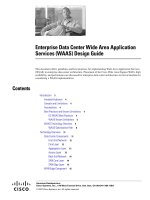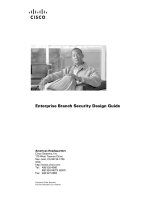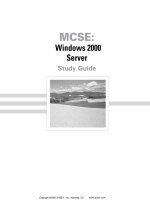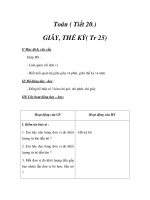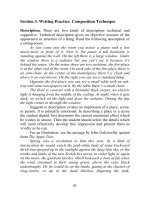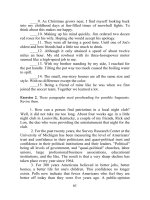Tài liệu Enterprise Mobility 4.1 Design Guide docx
Bạn đang xem bản rút gọn của tài liệu. Xem và tải ngay bản đầy đủ của tài liệu tại đây (15.66 MB, 368 trang )
Americas Headquarters
Cisco Systems, Inc.
170 West Tasman Drive
San Jose, CA 95134-1706
USA
Tel: 408 526-4000
800 553-NETS (6387)
Fax: 408 527-0883
Enterprise Mobility 4.1 Design Guide
Cisco Validated Design I
October 31, 2007
Customer Order Number:
Text Part Number: OL-14435-01
Cisco Validated Design
The Cisco Validated Design Program consists of systems and solutions designed, tested, and
documented to facilitate faster, more reliable, and more predictable customer deployments. For more
information visit www.cisco.com/go/validateddesigns.
ALL DESIGNS, SPECIFICATIONS, STATEMENTS, INFORMATION, AND RECOMMENDATIONS (COLLECTIVELY,
"DESIGNS") IN THIS MANUAL ARE PRESENTED "AS IS," WITH ALL FAULTS. CISCO AND ITS SUPPLIERS DISCLAIM
ALL WARRANTIES, INCLUDING, WITHOUT LIMITATION, THE WARRANTY OF MERCHANTABILITY, FITNESS FOR A
PARTICULAR PURPOSE AND NONINFRINGEMENT OR ARISING FROM A COURSE OF DEALING, USAGE, OR TRADE
PRACTICE. IN NO EVENT SHALL CISCO OR ITS SUPPLIERS BE LIABLE FOR ANY INDIRECT, SPECIAL,
CONSEQUENTIAL, OR INCIDENTAL DAMAGES, INCLUDING, WITHOUT LIMITATION, LOST PROFITS OR LOSS OR
DAMAGE TO DATA ARISING OUT OF THE USE OR INABILITY TO USE THE DESIGNS, EVEN IF CISCO OR ITS SUPPLIERS
HAVE BEEN ADVISED OF THE POSSIBILITY OF SUCH DAMAGES.
THE DESIGNS ARE SUBJECT TO CHANGE WITHOUT NOTICE. USERS ARE SOLELY RESPONSIBLE FOR THEIR
APPLICATION OF THE DESIGNS. THE DESIGNS DO NOT CONSTITUTE THE TECHNICAL OR OTHER PROFESSIONAL
ADVICE OF CISCO, ITS SUPPLIERS OR PARTNERS. USERS SHOULD CONSULT THEIR OWN TECHNICAL ADVISORS
BEFORE IMPLEMENTING THE DESIGNS. RESULTS MAY VARY DEPENDING ON FACTORS NOT TESTED BY CISCO.
CCVP, the Cisco Logo, and the Cisco Square Bridge logo are trademarks of Cisco Systems, Inc.; Changing the Way We Work, Live,
Play, and Learn is a service mark of Cisco Systems, Inc.; and Access Registrar, Aironet, BPX, Catalyst, CCDA, CCDP, CCIE, CCIP,
CCNA, CCNP, CCSP, Cisco, the Cisco Certified Internetwork Expert logo, Cisco IOS, Cisco Press, Cisco Systems, Cisco Systems
Capital, the Cisco Systems logo, Cisco Unity, Enterprise/Solver, EtherChannel, EtherFast, EtherSwitch, Fast Step, Follow Me
Browsing, FormShare, GigaDrive, GigaStack, HomeLink, Internet Quotient, IOS, iPhone, IP/TV, iQ Expertise, the iQ logo, iQ Net
Readiness Scorecard, iQuick Study, LightStream, Linksys, MeetingPlace, MGX, Networking Academy, Network Registrar, Packet,
PIX, ProConnect, RateMUX, ScriptShare, SlideCast, SMARTnet, StackWise, The Fastest Way to Increase Your Internet Quotient, and
TransPath are registered trademarks of Cisco Systems, Inc. and/or its affiliates in the United States and certain other countries.
All other trademarks mentioned in this document or Website are the property of their respective owners. The use of the word partner
does not imply a partnership relationship between Cisco and any other company. (0612R)
Enterprise Mobility 4.1 Design Guide
© 2007 Cisco Systems, Inc. All rights reserved.
i
Enterprise Mobility 4.1 Design Guide
OL-14435-01
CONTENTS
Preface i-i
Document Purpose i-i
Intended Audience i-i
Document Organization i-i
CHAPTER
1 Cisco Unified Wireless Network Solution Overview 1-1
WLAN Introduction 1-1
WLAN Solution Benefits 1-1
Requirements of WLAN Systems 1-2
Cisco Unified Wireless Network 1-5
CHAPTER
2 Cisco Unified Wireless Technology and Architecture 2-1
LWAPP Overview 2-1
Split MAC 2-2
Layer 2 and Layer 3 Tunnels 2-4
Layer 2 Tunnel 2-4
Layer 3 Tunnel 2-5
WLC Discovery and Selection 2-8
Components 2-9
WLCs 2-9
APs 2-10
Cisco Standalone APs 2-10
Cisco LWAPP APs 2-11
Mobility Groups, AP Groups, and RF Groups 2-13
Mobility Groups 2-13
Mobility Group Definition 2-14
Mobility Group Application 2-15
Mobility Group—Exceptions 2-15
AP Groups 2-15
RF Groups 2-16
Roaming 2-17
WLC to WLC Roaming Across Client Subnets 2-18
Contents
ii
Enterprise Mobility 4.1 Design Guide
OL-14435-01
Important Notes About Layer 3 Roaming 2-22
Broadcast and Multicast on the WLC 2-22
WLC Broadcast and Multicast Details 2-24
DHCP 2-24
ARP 2-24
Other Broadcast and Multicast Traffic 2-25
Design Considerations 2-25
WLC Location 2-26
Centralizing WLCs 2-27
Distributed WLC Network Connectivity 2-28
Traffic Load and Wired Network Performance 2-30
AP Connectivity 2-31
Operation and Maintenance 2-31
WLC Discovery 2-31
AP Distribution 2-32
Firmware Changes 2-32
CHAPTER
3 WLAN Radio Frequency Design Considerations 3-1
RF Basics 3-1
Regulatory Domains 3-1
Operating Frequencies 3-2
802.11b/g Operating Frequencies and Data Rates 3-3
802.11a Operating Frequencies and Data Rates 3-3
Understanding the IEEE 802.11 Standards 3-6
Direct Sequence Spread Spectrum 3-7
IEEE 802.11b Direct Sequence Channels 3-7
IEEE 802.11g 3-8
IEEE 802.11a OFDM Physical Layer 3-9
IEEE 802.11a Channels 3-9
RF Power Terminology 3-10
dB 3-10
dBi 3-10
dBm 3-10
Effective Isotropic Radiated Power 3-11
Planning for RF Deployment 3-11
Different Deployment Types of Overlapping WLAN Coverage 3-12
Data-Only Deployment 3-12
Voice/Deployment 3-13
Location-Based Services Deployments 3-14
Contents
iii
Enterprise Mobility 4.1 Design Guide
OL-14435-01
WLAN Data Rate Requirements 3-16
Data Rate Compared to Coverage Area 3-16
AP Density for Different Data Rates 3-17
Client Density and Throughput Requirements 3-19
WLAN Coverage Requirements 3-20
Power Level and Antenna Choice 3-21
Omni-Directional Antennas 3-21
Patch Antennas 3-22
Security Policy Requirements 3-23
RF Environment 3-23
RF Deployment Best Practices 3-24
Manually Fine-Tuning WLAN Coverage 3-25
Channel and Data Rate Selection 3-25
Recommendations for Channel Selection 3-25
Manual Channel Selection 3-26
Data Rate Selection 3-28
Radio Resource Management (Auto-RF) 3-30
Overview of Auto-RF Operation 3-30
Auto-RF Variables and Settings 3-31
Sample show ap auto-rf Command Output 3-34
Dynamic Channel Assignment 3-35
Interference Detection and Avoidance 3-35
Dynamic Transmit Power Control 3-36
Coverage Hole Detection and Correction 3-36
Client and Network Load Balancing 3-36
CHAPTER
4 Cisco Unified Wireless Network Architecture—Base Security Features 4-1
Base 802.11 Security Features 4-1
WLAN Security Implementation Criteria 4-1
Terminology 4-3
802.1X 4-4
Extensible Authentication Protocol 4-5
Authentication 4-6
Supplicants 4-6
Authenticator 4-7
Authentication Server 4-9
Encryption 4-10
WEP 4-11
TKIP Encryption 4-11
Contents
iv
Enterprise Mobility 4.1 Design Guide
OL-14435-01
AES Encryption 4-12
Four-Way Handshake 4-13
Cisco Compatible Extensions 4-14
Proactive Key Caching and CCKM 4-16
Cisco Unified Wireless Network Architecture 4-18
LWAPP Features 4-19
Cisco Unified Wireless Security Features 4-20
Enhanced WLAN Security Options 4-20
Local EAP Authentication 4-22
ACL and Firewall Features 4-24
DHCP and ARP Protection 4-24
Peer-to-Peer Blocking 4-25
Wireless IDS 4-25
Client Exclusion 4-26
Rogue AP 4-27
Air/RF Detection 4-28
Location 4-29
Wire Detection 4-29
Rogue AP Containment 4-30
Management Frame Protection 4-30
Client Management Frame Protection 4-33
WCS Security Features 4-33
Configuration Verification 4-33
Alarms and Reports 4-34
Architecture Integration 4-35
Cisco Integrated Security Features 4-36
Types of Attacks 4-36
MAC Flooding Attack 4-36
DHCP Rogue Server Attack 4-37
DHCP Starvation Attack 4-37
ARP Spoofing-based Man-In-the-Middle Attack 4-37
IP Spoofing Attack 4-37
CISF for Wireless Deployment Scenarios 4-37
Using CISF for Wireless Features 4-39
Using Port Security to Mitigate a MAC Flooding Attack 4-39
Using Port Security to Mitigate a DHCP Starvation Attack 4-40
Using DHCP Snooping to Mitigate a Rogue DHCP Server Attack 4-41
Using Dynamic ARP Inspection to Mitigate a Man-in-the-Middle Attack 4-42
Using IP Source Guard to Mitigate IP and MAC Spoofing 4-44
Contents
v
Enterprise Mobility 4.1 Design Guide
OL-14435-01
Summary of Findings 4-46
References 4-47
CHAPTER
5 Cisco Unified Wireless QoS 5-1
QoS Overview 5-1
Wireless QoS Deployment Schemes 5-2
QoS Parameters 5-2
Upstream and Downstream QoS 5-3
QoS and Network Performance 5-4
802.11 DCF 5-4
Interframe Spaces 5-5
Random Backoff 5-5
CWmin, CWmax, and Retries 5-6
Wi-Fi Multimedia 5-7
WMM Access 5-7
WMM Classification 5-7
WMM Queues 5-9
EDCA 5-10
U-APSD 5-12
TSpec Admission Control 5-14
QoS Advanced Features for WLAN Infrastructure 5-16
IP Phones 5-19
Setting the Admission Control Parameters 5-19
Impact of TSpec Admission Control 5-21
802.11e, 802.1P, and DSCP Mapping 5-22
QoS Baseline Priority Mapping 5-23
Deploying QoS Features on LWAPP-based APs 5-23
WAN QoS and the H-REAP 5-24
Guidelines for Deploying Wireless QoS 5-24
Throughput 5-24
QoS Example LAN Switch Configuration 5-25
AP Switch Configuration 5-25
WLC Switch Configuration 5-25
Traffic Shaping, Over the Air QoS, and WMM Clients 5-26
WLAN Voice and the Cisco 7921G and 7920 5-26
LWAPP over WAN Connections 5-26
LWAPP Traffic Classification 5-27
LWAPP Control Traffic 5-27
LWAPP 802.11 Traffic 5-30
Contents
vi
Enterprise Mobility 4.1 Design Guide
OL-14435-01
Classification Considerations 5-30
LWAPP Traffic Volumes 5-30
Example Router Configurations 5-30
CHAPTER
6 Cisco Unified Wireless Multicast Design 6-1
Introduction 6-1
Overview of Multicast Forwarding in Cisco Unified Wireless Networks 6-1
Wireless Multicast Roaming 6-3
Asymmetric Multicast Tunneling 6-3
Multicast Enabled Networks 6-4
LWAPP Multicast Reserved Ports and Addresses 6-4
Enabling Multicast Forwarding on the Controller 6-5
CLI Commands to Enable Ethernet Multicast Mode 6-5
Multicast Deployment Considerations 6-6
Recommendations for Choosing an LWAPP Multicast Address 6-6
Fragmentation and LWAPP Multicast Packets 6-6
All Controllers have the Same LWAPP Multicast Group 6-7
Controlling Multicast on the WLAN Using Standard Multicast Techniques 6-7
How Controller Placement Impacts Multicast Traffic and Roaming 6-9
Additional Considerations 6-10
CHAPTER
7 Cisco Unified Wireless Hybrid REAP 7-1
Remote Edge AP 7-1
Hybrid REAP 7-2
Supported Platforms 7-2
WLAN WLCs 7-2
Access Points 7-3
H-REAP Terminology 7-3
Switching Modes 7-3
Operation Modes 7-3
H-REAP States 7-4
Applications 7-6
Branch Wireless Connectivity 7-6
Branch Guest Access 7-7
Public WLAN Hotspot 7-8
Unified Wireless Feature Support 7-9
Deployment Considerations 7-10
Roaming 7-11
WAN Link Disruptions 7-13
Contents
vii
Enterprise Mobility 4.1 Design Guide
OL-14435-01
H-REAP Limitations and Caveats 7-14
Restricting Inter-Client Communication 7-16
H-REAP Scaling 7-16
Inline Power 7-17
Management 7-17
H-REAP Configuration 7-17
Initial Configuration 7-17
Serial Console Port 7-17
DHCP with Statically Configured WLC IPs 7-19
Configuring LAP for H-REAP Operation 7-19
Enabling VLAN Support 7-21
Advanced Configuration 7-21
Choosing WLANs for Local Switching 7-22
H-REAP Local Switching (VLAN) Configuration 7-23
WLC Dynamic Interface Configuration for Remote Only WLANs 7-25
H-REAP Verification 7-25
Verifying the H-REAP AP Addressing 7-25
Verifying the WLC Resolution Configuration 7-25
Troubleshooting 7-26
H-REAP Does Not Join the WLC 7-26
Client Associated to Local Switched WLAN Cannot Obtain an IP Address 7-26
Client Cannot Authenticate or Associate to Locally Switched WLAN 7-26
Client Cannot Authenticate or Associate to the Central Switched WLAN 7-27
H-REAP Debug Commands 7-27
H-REAP AP Debug Commands 7-27
CHAPTER
8 Cisco Wireless Mesh Networking 8-1
Introduction 8-1
Cisco 1500 Series Mesh AP 8-2
Cisco Wireless LAN Controllers 8-4
Wireless Control System (WCS) 8-5
Wireless Mesh Operation 8-5
Bridge Authentication 8-6
Wireless Mesh Encryption 8-6
AWPP Wireless Mesh Routing 8-7
Example Simple Mesh Deployment 8-7
Mesh Neighbors, Parents, and Children 8-10
Background Scanning in Mesh Networks 8-12
Ease Calculation 8-14
Contents
viii
Enterprise Mobility 4.1 Design Guide
OL-14435-01
SNR Smoothing 8-14
Loop Prevention 8-14
Choosing the Best Mesh Parent 8-15
Routing Around an Interface 8-15
Design Details 8-15
Wireless Mesh Design Constraints 8-16
Client WLAN 8-16
Bridging Backhaul Packets 8-16
Client Access on Backhaul Connections 8-17
Increasing Mesh Availability 8-17
Multiple RAPs 8-19
Multiple Controllers 8-20
Multiple Wireless Mesh Mobility Groups 8-21
Design Example 8-21
MAP Density and Distance 8-21
Connecting the Cisco 1500 Mesh AP to your Network 8-24
Physical Placement of Mesh APs 8-25
AP 1500 Alternate Deployment Options 8-26
Wireless Backhaul 8-26
Point-to-Multipoint Wireless Bridging 8-26
10.6.3 Point-to-Point Wireless Bridging 8-27
CHAPTER
9 VoWLAN Design Recommendations 9-1
Antenna Considerations 9-1
AP Antenna Selection 9-1
Antenna Positioning 9-3
Handset Antennas 9-3
Channel Utilization 9-3
Dynamic Frequency Selection (DFS) and 802.11h Requirements of the APs 9-4
Channels in the 5 GHz Band 9-5
Call Capacity 9-7
AP Call Capacity 9-10
Cell Edge Design 9-12
Dual Band Coverage Cells 9-14
Dynamic Transmit Power Control 9-14
Interference Sources Local to the User 9-15
Contents
ix
Enterprise Mobility 4.1 Design Guide
OL-14435-01
CHAPTER
10 Cisco Unified Wireless Guest Access Services 10-1
Introduction 10-1
Scope 10-2
Wireless Guest Access Overview 10-2
Guest Access using the Cisco Unified Wireless Solution 10-2
WLAN Controller Guest Access 10-3
Supported Platforms 10-4
Auto Anchor Mobility to Support Wireless Guest Access 10-4
Anchor Controller Deployment Guidelines 10-6
Anchor Controller Positioning 10-6
DHCP Services 10-7
Routing 10-7
Anchor Controller Sizing and Scaling 10-7
Anchor Controller Redundancy 10-7
Web Portal Authentication 10-8
User Redirection 10-9
Guest Credentials Management 10-10
Local Controller Lobby Admin Access 10-11
Guest User Authentication 10-11
External Authentication 10-12
Guest Pass-through 10-12
Guest Access Configuration 10-14
Anchor WLC Installation and Interface Configuration 10-15
Guest VLAN Interface Configuration 10-16
Mobility Group Configuration 10-18
Defining the Default Mobility Domain Name for the Anchor WLC 10-18
Defining Mobility Group Members of the Anchor WLC 10-19
Adding the Anchor WLC as a Mobility Group Member of a Foreign WLC 10-20
Guest WLAN Configuration 10-20
Foreign WLC—Guest WLAN Configuration 10-21
Guest WLAN Configuration on the Anchor WLC 10-27
Anchor WLC—Guest WLAN Interface 10-28
Guest Account Management 10-29
Guest Management Using WCS 10-30
Using the Add Guest User Template 10-31
Using the Schedule Guest User Template 10-34
Managing Guest Credentials Directly on the Anchor Controller 10-39
Configuring the Maximum Number of User Accounts 10-40
Maximum Concurrent User Logins 10-40
Contents
x
Enterprise Mobility 4.1 Design Guide
OL-14435-01
Guest User Management Caveats 10-41
Other Features and Solution Options 10-41
Web Portal Page Configuration and Management 10-41
Internal Web Page Management 10-42
Internal Web Certificate Management 10-44
Support for External Web Redirection 10-45
Anchor WLC-Pre-Authentication ACL 10-46
Anchor Controller DHCP Configuration 10-48
Adding a New DHCP Scope to the Anchor Controller 10-48
External Radius Authentication 10-49
Adding a RADIUS Server 10-50
External Access Control 10-52
Verifying Guest Access Functionality 10-54
Troubleshooting Guest Access 10-54
System Monitoring 10-56
Debug Commands 10-59
CHAPTER
11 Mobile Access Router, Universal Bridge Client, and Cisco Unified Wireless 11-1
3200 Series Mobile Access Router Overview 11-1
Cisco 3200 Series and Wireless Network Access 11-2
Vehicle Network Example 11-2
Simple Bridge Client Data Path Example 11-3
Cisco 3200 Series in Mobile IP Environments 11-4
WMIC Roaming Algorithm 11-5
Basic Configuration Examples 11-6
Connecting to the Cisco 32XX 11-6
Configure IP Address, DHCP, VLAN on 3200 Series 11-6
WMIC Configurations 11-7
WMIC Work Group Bridge Configuration 11-7
WMIC Universal Bridge Client Configuration 11-8
WMIC as an Access Point Configuration 11-8
Security 11-8
Authentication Types 11-8
Encryption and Key Management 11-9
Security Configuration 11-9
Assigning Authentication Types to an SSID 11-9
Configuring dot1x Credentials 11-11
EAP-TLS Authentication with AES Encryption Example 11-12
Configuring the Root Device Interaction with WDS 11-13
Contents
xi
Enterprise Mobility 4.1 Design Guide
OL-14435-01
Configuring Additional WPA Settings 11-14
WPA and Pre-shared Key Configuration Example 11-14
Cisco 3200 Series Product Details 11-15
Cisco 3200 Series Interfaces 11-15
Cisco 3230 Enclosure Connections 11-16
Cisco 3270 Rugged Enclosure Configuration 11-16
Cisco 3200 Series WMIC Features 11-18
Cisco 3200 Series Bridge Considerations 11-19
Cisco 3200 Series Management Options 11-21
CHAPTER
12 Cisco Unified Wireless and Mobile IP 12-1
Introduction 12-1
Different Levels of Network Mobility 12-1
Requirements for a Mobility Solution 12-3
Location Database 12-4
Move Discovery, Location Discovery, and Update Signaling 12-4
Path Re-establishment 12-5
Roaming on a Cisco Unified Wireless Network 12-5
Roaming on a Mobile IP-enabled Network 12-6
Configuration 1: Sample Mobile IP Client Interface and Host Table Manipulation 12-9
Mobile IP Client Characteristics When Roaming on a Cisco Unified Wireless Network 12-10
CHAPTER
13 Cisco Unified Wireless Location-Based Services 13-1
Introduction 13-1
Reference Publications 13-2
Cisco Location-Based Services Architecture 13-2
Positioning Technologies 13-2
What is RF Fingerprinting? 13-3
Overall Architecture 13-4
Role of the Cisco Wireless Location Appliance 13-6
Accuracy and Precision 13-8
Tracking Assets and Rogue Devices 13-9
Cisco Location Control Protocol 13-10
Installation and Configuration 13-11
Installing and Configuring the Location Appliance and WCS 13-11
Deployment Best Practices 13-13
Location-Aware WLAN Design Considerations 13-13
RFID Tag Considerations 13-14
Contents
xii
Enterprise Mobility 4.1 Design Guide
OL-14435-01
SOAP/XML Application Programming Interface 13-15
i
Enterprise Mobility 4.1 Design Guide
OL-14435-01
Preface
Document Purpose
The purpose of this document is to describe the design and implementation of the Cisco Unified Wireless
Network solution for the enterprise, using the features incorporated in the Wireless LAN Controller
software Release 4.1.
Intended Audience
This publication is for experienced network administrators who are responsible for design and
implementation of wireless networks.
Document Organization
The following table lists and briefly describes the chapters of this guide.
Section Description
Chapter 1, “Cisco Unified
Wireless Network Solution
Overview.”
Summarizes the benefits and characteristics of the Cisco Unified
Wireless Network for the enterprise.
Chapter 2, “Cisco Unified
Wireless Technology and
Architecture.”
Discusses the key design and operational considerations in an
enterprise Cisco Unified Wireless Deployment.
Chapter 3, “WLAN Radio
Frequency Design
Considerations.”
Describes the basic radio frequency (RF) information necessary
to understand RF considerations in various wireless local area
network (WLAN) environments.
Chapter 4, “Cisco Unified
Wireless Network
Architecture—Base Security
Features.”
Describes the natively available 802.11 security options and the
advanced security features in the Cisco Unified Wireless solution,
and how these can be combined to create an optimal WLAN
solution.
Chapter 5, “Cisco Unified
Wireless QoS.”
Describes quality-of-service (QoS) in the context of WLAN
implementations.
ii
Enterprise Mobility 4.1 Design Guide
OL-14435-01
Preface
Document Organization
Chapter 6, “Cisco Unified
Wireless Multicast Design.”
Describes the improvements that have been made in IP multicast
forwarding and provides information on how to deploy multicast
in a wireless environment.
Chapter 7, “Cisco Unified
Wireless Hybrid REAP.”
Describes the Cisco Centralized WLAN architecture and its use
of H-REAP.
Chapter 8, “Cisco Wireless Mesh
Networking.”
Describes the use of wireless mesh.
Chapter 9, “VoWLAN Design
Recommendations.”
Provide design considerations when deploying voice over WLAN
(VoWLAN) solutions.
Chapter 10, “Cisco Unified
Wireless Guest Access Services.”
Describes the use of guest access services in the centralized
WLAN architecture.
Chapter 11, “Mobile Access
Router, Universal Bridge Client,
and Cisco Unified Wireless.”
Describes the use of the mobile access router, universal bridge
client, and mesh networks.
Chapter 12, “Cisco Unified
Wireless and Mobile IP.”
Describes the inter-workings of the Cisco Mobile Client (CMC)
over a Cisco Unified Wireless Network (WiSM).
Chapter 13, “Cisco Unified
Wireless Location-Based
Services.”
Discusses the Cisco Location-Based Service (LBS) solution and
the areas that merit special consideration involving design,
configuration, installation, and deployment.
Glossary Lists and defines key terms used in the guide.
Section Description
CHAPTER
1-1
Enterprise Mobility 4.1 Design Guide
OL-14435-01
1
Cisco Unified Wireless Network Solution
Overview
This chapter summarizes the benefits and characteristics of the Cisco Unified Wireless Network for the
enterprise.The Cisco Unified Wireless Network solution offers secure, scalable, cost-effective wireless
LANs for business critical mobility.
The Cisco Unified Wireless Network is the industry’s only unified
wired and wireless solution to cost-effectively address the wireless LAN (WLAN) security, deployment,
management, and control issues facing enterprises. This powerful indoor and outdoor solution combines
the best elements of wired and wireless networking to deliver high performance, manageable, and secure
WLANs with a low total cost of ownership.
WLAN Introduction
The mobile user requires the same accessibility, security, quality-of-service (QoS), and high availability
currently enjoyed by wired users. Whether you are at work, at home, on the road, locally or
internationally, there is a need to connect. The technological challenges are apparent, but to this end,
mobility plays a role for everyone. Companies are deriving business value from mobile and wireless
solutions. What was once a vertical market technology is now mainstream, and is an essential tool in
getting access to voice, real-time information, and critical applications such as e-mail and calendar,
enterprise databases, supply chain management, sales force automation, and customer relationship
management.
WLAN Solution Benefits
WLANs provide the user with a new way to communicate while accommodating the way business is
done now. The following benefits are achieved by WLANs:
• Mobility within building or campus—Facilitates implementation of applications that require an
always-on network and that tend to involve movement within a campus environment.
• Convenience—Simplifies networking of large, open people areas.
• Flexibility—Allows work to be done at the most appropriate or convenient place rather than where
a cable drop terminates. Getting the work done is what is important, not where you are.
• Easier to set-up temporary spaces—Promotes quick network setup of meeting rooms, war rooms, or
brainstorming rooms tailored to variations in the number of participants.
• Lower cabling costs—Reduces the requirement for contingency cable plant installation because the
WLAN can be employed to fill the gaps.
1-2
Enterprise Mobility 4.1 Design Guide
OL-14435-01
Chapter 1 Cisco Unified Wireless Network Solution Overview
Requirements of WLAN Systems
• Easier adds, moves, and changes and lower support and maintenance costs—Temporary networks
become much easier to set up, easing migration issues and costly last-minute fixes.
• Improved efficiency—Studies show WLAN users are connected to the network 15 percent longer per
day than hard-wired users.
• Productivity gains—Promotes easier access to network connectivity, resulting in better use of
business productivity tools. Productivity studies show a 22 percent increase for WLAN users.
• Easier to collaborate—Facilitates access to collaboration tools from any location, such as meeting
rooms; files can be shared on the spot and requests for information handled immediately.
• More efficient use of office space—Allows greater flexibility for accommodating groups, such as
large team meetings.
• Reduced errors—Data can be directly entered into systems as it is being collected, rather than when
network access is available.
• Improved efficiency, performance, and security for enterprise partners and guests—Promoted by
implementing guest access networks.
• Improved business resilience—Increased mobility of the workforce allows rapid redeployment to
other locations with WLANs.
Requirements of WLAN Systems
WLAN systems run either as an adjunct to the existing wired enterprise network or as a free-standing
network within a campus or branch, individual teleworker, or tied to applications in the retail,
manufacturing, or healthcare industries. WLANs must permit secure, encrypted, authorized
communication with access to data, communication, and business services as if connected to the
resources by wire.
WLANs must be able to do the following:
• Maintain accessibility to resources while employees are not wired to the network—This
accessibility enables employees to respond more quickly to business needs regardless of whether
they are meeting in a conference room with a customer, at lunch with coworkers in the company
cafeteria, or collaborating with a teammate in the next building.
• Secure the enterprise from unauthorized, unsecured, or “rogue” WLAN access points—IT managers
must be able to easily and automatically detect and locate rogue access points and the switch ports
to which they are connected, active participation of both access points, and client devices that are
providing continuous scanning and monitoring of the RF environment.
• Extend the full benefits of integrated network services to nomadic users—IP telephony and IP
video-conferencing are supported over the WLAN using QoS, which by giving preferential
treatment to real-time traffic, helps ensure that the video and audio information arrives on time.
Firewall and Intruder Detection that are part of the enterprise framework are extended to the
wireless user.
• Segment authorized users and block unauthorized users—Services of the wireless network can be
safely extended to guests and vendors. The WLAN must be able to configure support for a separate
public network—a guest network.
• Provide easy, secure network access to visiting employees from other sites—There is no need to
search for an empty cubicle or an available Ethernet port. Users should securely access the network
from any WLAN location. Employees are authenticated through IEEE 802.1x and Extensible
Authentication Protocol (EAP), and all information sent and received on the WLAN is encrypted.
1-3
Enterprise Mobility 4.1 Design Guide
OL-14435-01
Chapter 1 Cisco Unified Wireless Network Solution Overview
Requirements of WLAN Systems
• Easily manage central or remote access points—Network managers must be able to easily deploy,
operate, and manage hundreds to thousands of access points within the WLAN campus deployments
and branch offices or retail, manufacturing, and health care locations. The desired result is one
framework that provides medium-sized to large organizations the same level of security, scalability,
reliability, ease of deployment, and management that they have come to expect from their wired
LANs.
• Enhanced Security Services—WLAN Intrusion Prevention System (IPS) and Intrusion Detection
System (IDS) control to contain wireless threats, enforce security policy compliance, and safeguard
information.
• Voice Services—Brings the mobility and flexibility of wireless networking to voice
communications via the Cisco Unified Wired and Wireless network and the Cisco Compatible
Extensions voice-enabled client devices.
• Location Services — Simultaneous tracking of hundreds to thousands of Wi-Fi and active RFID
devices from directly within the WLAN infrastructure for critical applications such as high-value
asset tracking, IT management, location-based security, and business policy enforcement.
• Guest Access— Provides customers, vendors, and partners with easy access to a wired and wireless
LANs, helps increase productivity, facilitates real-time collaboration, keeps the company
competitive, and maintains full WLAN security.
WLANs in the enterprise have emerged as one of the most effective means for connecting to a network.
Figure 1-1 shows the elements of the Cisco Unified Wireless Network.
1-4
Enterprise Mobility 4.1 Design Guide
OL-14435-01
Chapter 1 Cisco Unified Wireless Network Solution Overview
Requirements of WLAN Systems
Figure 1-1 Cisco Unified Wireless Network Architecture in the Enterprise
Browser Based
Cisco
Wireless
Location
Appliance
Third Party
Integrated
Applications:
E911, Asset
Tracking, ERP,
Workflow
Automation
Cisco WCS
Navigator
Cisco Aironet
Lightweight
Access Points
(802.11a/b/g
and 802.11n)
Cisco
Compatible
Wi-Fi Tags
Chokepoint
125 kHz
Cisco
Compatible
Client
Devices
Cisco Aironet
Wireless Bridge
Cisco Wireless
LAN Controller
Cisco Wireless
LAN Controller
Module (WLCM)
Cisco Catalyst
3750G Integrated
Wireless LAN
Controller
Cisco Aironet
1500 Series
Lightweight
Outdoor Mesh
Access Points
Cisco Catalyst 6500
Series Wireless
Services Module
(WiSM)
Cisco Aironet
Wireless LAN
Client Adapters
Cisco
WCS
Cisco Wireless
Control System
(WCS)
Cisco
WCS
W
E
S
N
222279
1-5
Enterprise Mobility 4.1 Design Guide
OL-14435-01
Chapter 1 Cisco Unified Wireless Network Solution Overview
Cisco Unified Wireless Network
The following five interconnected elements work together to deliver a unified enterprise-class wireless
solution:
• Client devices
• Access points
• Network unification
• World-class network management
• Mobility services
Beginning with a base of client devices, each element adds capabilities as the network needs evolve and
grow, interconnecting with the elements above and below it to create a comprehensive, secure WLAN
solution.
The Cisco Unified Wireless Network cost-effectively addresses the WLAN security, deployment,
management, and control issues facing enterprises. This framework integrates and extends wired and
wireless networks to deliver scalable, manageable, and secure WLANs with the lowest total cost of
ownership. The Cisco Unified Wireless Network provides the same level of security, scalability,
reliability, ease of deployment, and management for wireless LANs that organizations expect from their
wired LANs.
For more information about the Cisco Unified Wireless Network, see the following URL:
/>Cisco Unified Wireless Network
The core feature set of the Cisco Unified Wireless Network includes Cisco Aironet access points (APs),
the Wireless Control System (WCS), and Wireless LAN Controllers (WLC), including the Cisco
Catalyst 6500 Wireless Services Module (WiSM), the 440X, the 2106 WLC, the WLCM ISR module,
and the WS-C3750G integrated controller.
The core feature set is currently deployable in the following configurations:
• APs and WLC
• APs, WLCs, and WCS
• APs, WLC, WCS, and LBS
Adding optional Cisco Compatible Extensions client devices and the Cisco Secure Services Client
provides additional benefits, including advanced enterprise-class security, extended RF management,
and enhanced interoperability.
1-6
Enterprise Mobility 4.1 Design Guide
OL-14435-01
Chapter 1 Cisco Unified Wireless Network Solution Overview
Cisco Unified Wireless Network
CHAPTER
2-1
Enterprise Mobility 4.1 Design Guide
OL-14435-01
2
Cisco Unified Wireless Technology and
Architecture
This chapter discusses the key design and operational considerations associated with an enterprise Cisco
Unified Wireless deployment.
This chapter examines the following:
• LWAPP
• Roaming
• Broadcast and multicast handling
• Product choices
• Deployment considerations
Much of the material in this chapter is explained in more detail in later chapters of the document.
Recommended reading for more detail on the Cisco Unified Wireless Technology is Deploying Cisco
440X Series Wireless LAN Controllers at the following URL:
/>LWAPP Overview
Lightweight Access Point Protocol (LWAPP) is the underlying protocol used in Cisco’s centralized
WLAN architecture. It provides for the configuration and management of WLAN(s), in addition to
tunneling WLAN client traffic to and from a centralized WLAN controller (WLC). Figure 2-1 shows a
high level diagram of a basic centralized WLAN architecture, where LWAPP APs connect to a WLC
via LWAPP.
Note Because the foundational WLAN features are the same, the term WLC is used generically to represent
all Cisco WLAN Controllers, regardless of whether the controller is a standalone appliance, an ISR with
a WLC module; or a Catalyst switch with a service module or integrated WLC.
2-2
Enterprise Mobility 4.1 Design Guide
OL-14435-01
Chapter 2 Cisco Unified Wireless Technology and Architecture
LWAPP Overview
Figure 2-1 LWAPP APs Connected to a WLC
The LWAPP protocol comprises of a number of functional components; however, only those that
influence the design and operation of a centralized WLAN network are discussed in this document.
The key features of LWAPP are:
• Split MAC tunnel
• L2 or L3 based tunnels
• WLC discovery process.
Split MAC
A key component of the LWAPP protocol is the concept of split MAC, where part of the 802.11 protocol
operation is managed by the LWAPP AP, while the remaining parts are managed by the WLC. A diagram
of the split MAC concept is shown in
Figure 2-2c.
A generic 802.11 AP, at the simplest level, is nothing more than an 802.11 MAC-layer radio that bridges
WLAN clients to a wired network based on association to a Basic Service Set Identifier (BSSID). See
Figure 2-2a. The 802.11 standard extends the single AP concept (above) to allow multiple APs to
provide an extended service set (ESS), where multiple APs use the same ESS identifier (ESSID,
commonly referred to as an SSID) to allow a WLAN client to connect to a common network via more
than one AP. See
Figure 2-2b.
The LWAPP split MAC concept takes all of the functions normally performed by individual APs and
distributes them between two functional components: an LWAPP AP and a WLC. The two are linked
across a network by the LWAPP protocol and together provide equivalent radio/bridging services in a
manner that is simpler to deploy and manage than individual APs.
Note Although ‘split MAC’ facilitates Layer 2 connectivity between the WLAN clients and the wired
interface of the WLC; this does not mean that the LWAPP tunnel will pass all traffic. The WLC forwards
only IP Ethertype frames, and its default behavior is to not forward broadcast and multicast traffic. This
is important to keep in mind when considering multicast and broadcast requirements in a WLAN
deployment.
190671
LWAPP
LWAPP
LWAPP
LWAPP
LWAPP
LWAPP
Layer 2 or
Layer 3
Network
2-3
Enterprise Mobility 4.1 Design Guide
OL-14435-01
Chapter 2 Cisco Unified Wireless Technology and Architecture
LWAPP Overview
Figure 2-2 Split MAC Concept
The simple timing-dependent operations are generally managed locally on the LWAPP AP, while more
complex, less time-dependent operations are managed on the WLC.
For example, the LWAPP AP handles the following:
• Frame exchange handshake between a client and AP
• Transmission of beacon frames
• Buffering and transmission of frames for clients in power save mode
• Response to probe request frames from clients; the probe requests are also sent to the WLC for
processing
• Forwarding notification of received probe requests to the WLC
• Provision of real-time signal quality information to the switch with every received frame
• Monitoring each of the radio channels for noise, interference, and other WLANs
• Monitoring for the presence of other APs
• Encryption and decryption of 802.11 frames
(B) APs combined into an ESS
190672
LWAPP
LWAPP
LWAPP
LWAPP
LWAPP
LWAPP
Network
(C) LWAPP Split-MAC ESS
LWAPP
LWAPP
LWAPP
LWAPP
(A) Single AP

